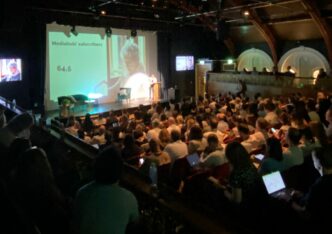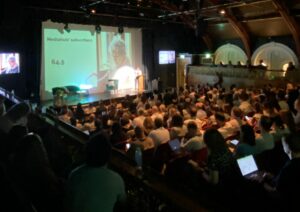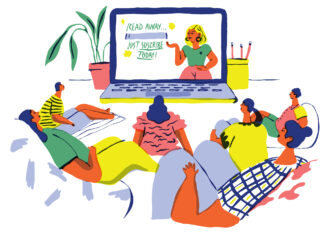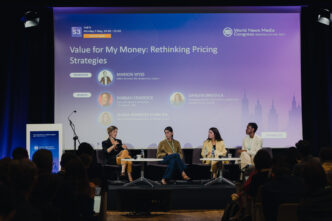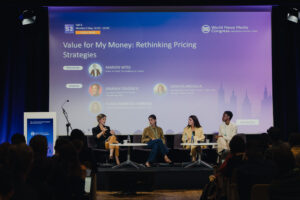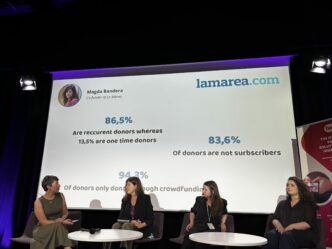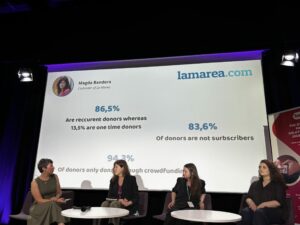

Morning Crunch is a newsletter-only media brand aimed at helping younger audiences to get informed on a topic in under 5 minutes each morning. Launched by ex-Burda Gregor Becker and ex-Ringier Paul Ostwald in 2023, the brand already has over 50,000 subscribers and a growing collection of daily newsletters, including markets crunch (on daily business news), deals crunch (on Private Equity, mergers & acquisitions) and ai crunch with automotive crunch and others to follow soon.
Clearly succeeding in acquiring and engaging younger audiences, there’s a lot of takeaways to support the wider publishing industry.
We interviewed Co-founder Paul on why they chose to target these readers, what strategies they’re using to achieve this and what they’d recommend to legacy publishers hoping to do the same.
Quick stats on Morning Crunch
- Launched in 2023
- Newsletter only
- Already 700 editions published
- 50,000 subscribers
- Team of 3
Why did you want to launch with younger readers in mind?
We’d actually already tried to launch a youth platform when I worked at Handelsblatt. But we didn’t manage to find the right tone, platform or way of getting information across to younger audiences. It’s a tough job for a legacy publication with an existing tone, audience and brand reputation.
Despite this failure, we know that there’s a huge gap in the German market – an estimated 1M young professionals in Germany – who aren’t really being targeted by legacy publishers. These readers have grown up with the challenges of stock crashes, lockdowns amidst the pandemic, challenging economic situations, etc. but no real news outlet to inform them in a way that actually helps them to understand what’s happening in all of this. The only ones doing this are self-proclaimed ‘influencers’ on social media.
What Gregor and I realized was that the formats and ways of telling stories needed to change if you wanted to attract and retain younger readers. That’s incredibly hard to do authentically if you’re a legacy publisher. If you have the freedom to dare to do something different, you’re in a better position.
In short, it’s better to start from scratch – even as a legacy publisher, you can launch a completely new standalone brand. Of course, that takes courage.
So you knew you wanted to target these readers, how are you doing this?
Adapted content and formats. For example:
- What we call ‘smart bullets’ – a way of explaining and illustrating a point in a short, concise and easy-to-digest format – a format that Axios has perfected
- Pop-culture references, humor and memes that resonate with young readers. This is also a more ‘daring’ format, and something that legacy publishers might be hesitant to do
- Topics that young readers care about, those that directly impact them – and explaining them in a way that is entertaining but also informative
- Adding a section “why this matters” to every story – that’s where we connect the bigger story to the individual reader
It’s also about the angle. We don’t just report what’s going on but how it’s impacting young readers and their realities. For instance, we wouldn’t just say “this event has impacted interest rates” but “open your banking app and you’ll probably see that this interest on your savings has declined, here’s why and how it will affect you long-term – and why crypto still isn’t the answer to declining interest rates”
We don’t yet have the team to do scoops, we have to find out which stories are interesting and relevant to our readers, understand the news, consider how it impacts them and give them our take.
> A must-read on the topic: Getting young people to subscribe means changing how we define journalism
We have to position ourselves as a smart friend, but we equally don’t want to talk down to people. It’s a tough balance to find.
Apart from the stable (and high) open rates, the signs that it’s working is that readers actually reply and contact us – they even correct us, and we put these corrections in the newsletter, showing that we, too, make mistakes. It’s about building close relationships as individuals, not just a brand.
“Young consumers’ definition of engaging storytelling looks very different to the traditional news report...The mass appeal of social media platforms and the explosion of new storytelling methods - including video, personalized interactives and documentary style podcasts, to name a few - has shifted consumer preferences towards being more visual and graphic, more immersive and more readily available.” Next Gen News Report 2024 research reveals that the next generation of news consumers have strong preferences for particular storytelling formats: 1. Convenience: “I don’t want this to require more effort than necessary” 2. Language: “I want words that I understand and a tone that is welcoming” 3. Format: I want this in a form that works for me and my situation”
What are your success metrics? How do you know you’re successfully attracting and retaining these readers?
We look at the classic newsletter metrics – open rates, click rates – as well as retention rates, a tricky one for newsletters. You always have readers who unsubscribe but also others who just stop reading. They don’t help with ad revenue, so you need to find who they are and re-engage them.
We keep track of how much feedback we get, replies and responses to our polls. This also helps us get a better idea of who is reading us – their age, profession, position in a company, etc.
“The business is currently monetized through advertising”
I definitely think it’s more valuable building a brand first and thinking of ROI more deeply in the future, so we only monetize through advertising for the moment. We also know that US examples like MorningBrew and Axios make a majority of their revenue from advertising.
The current newsletters, which are more general interest, don’t really suit a paid subscription model yet. We plan to go more deeply into niche topics in the future, where we provide extra data and value, and that’s where we’d also start thinking about paid offerings. But then there’s the question of whether our young audience really wants all of that.
For instance, a long, detailed daily newsletter may appear to be worth paying for, but are audiences going to read that for 2 hours every morning?
Best in class example: The FT Edit app where Financial Times built a lighter version of their product. This has value (and is worth paying for) in the fact that they carefully pick out the most important articles to read each day. It’s this curation that the reader is paying for.
The growth strategy
We’re planning to grow more newsletters, like Axios has done. It’s what we just completed a funding round on. The German market is definitely mature in its propensity to pay for quality news, in particular across niches. But many legacy publishers aren’t digital-first or catering towards the young professional. So we hope to fill this gap in the future, spreading out to the farming industry, auto-motive, etc.
It’s also essential that we stay with these younger readers, so we’ll hire a few young editors, but we’re also open to more senior editors who understand what we’re doing. We want to stay lean though, newsletters don’t need a large team.
What have you done differently to when you launched the youth platform with Handelsblatt that didn’t end up working?
Perhaps the fact that we’re starting from scratch, without any audience, rather than trying to build on an existing brand, and using the same platforms that we’ve already been using for other readers, sets us apart from traditional publishers. We don’t need to worry about the risks involved with testing new acquisition channels, or trying to change the reputation of an existing brand.
Plus, a legacy publisher might launch a product aimed at young readers and get a substantial number of sign-ups immediately after launch, but they’re not the right audience. It’s still the same readers that you had initially – and that means you now have a new way of monetizing your existing audience, but no new audience.
User acquisition
- Working closely with influencers and meme pages
- Trying new channels like Quora and Reddit
- Being bold in trying new ad formats, user-generated content for example
- Media companies don’t tend to use these acquisition sources because of the risks involved
Tonality
- Make jokes and be the joke, a lighter but well-informed take
- Deliver high-quality financial journalism and keep the banter to very few, and clearly marked, sections (e.g. Memes at the end of the newsletter)
Newsletter only
- Publishing houses would think hard about this strategy because of the single channel risk – on the other hand: newsletter brands have first party data, which many established brands do not
More flexibility
- We don’t have the concerns of brand safety and the risks of trying to gain younger readers whilst retaining existing ones
- Starting from scratch with an entirely new brand and no audience means we can work to acquire the readers in the right target market. For large brands, they might launch a newsletter aimed at young readers and get thousands of sign ups immediately, but they won’t likely be the right audience.
What would you recommend to anyone in a large publication trying to target young readers?
Ringier did a great job with Izzy projects, and FT with Sifted. A completely new brand meant freedom in playing around with the brand proposition, acquiring an entirely new audience all whilst having the benefit of expertise from the parent brand and sister companies who are one step ahead.
- Don’t do it under the same label
- Give freedom to the brand
- Bring in young people
- Be willing to give away some budget without predefined budget lines – you don’t know beforehand what a new brand needs
- Accept that this budget may not be used in the ways you initially planned, or in the ways that it may be used for legacy publishers

